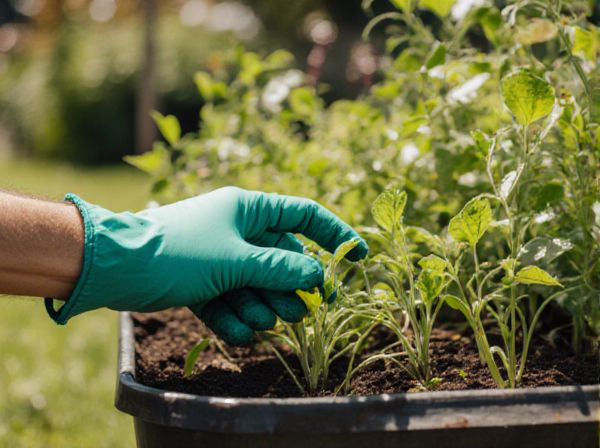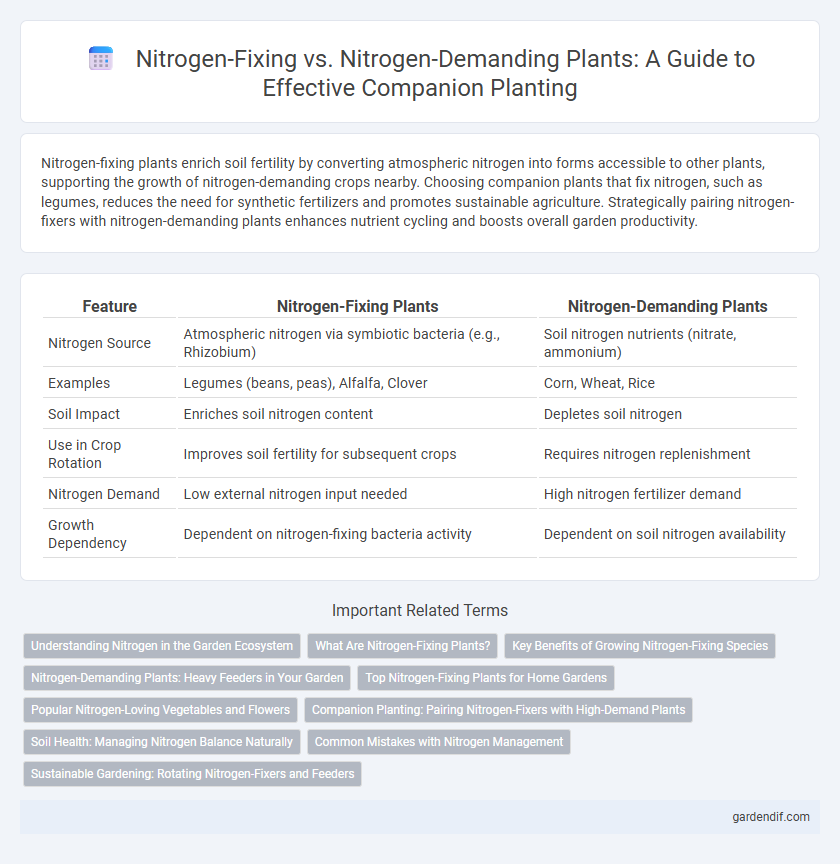
Nitrogen-fixing plants vs nitrogen-demanding plants Illustration
Nitrogen-fixing plants enrich soil fertility by converting atmospheric nitrogen into forms accessible to other plants, supporting the growth of nitrogen-demanding crops nearby. Choosing companion plants that fix nitrogen, such as legumes, reduces the need for synthetic fertilizers and promotes sustainable agriculture. Strategically pairing nitrogen-fixers with nitrogen-demanding plants enhances nutrient cycling and boosts overall garden productivity.
Table of Comparison
| Feature | Nitrogen-Fixing Plants | Nitrogen-Demanding Plants |
|---|---|---|
| Nitrogen Source | Atmospheric nitrogen via symbiotic bacteria (e.g., Rhizobium) | Soil nitrogen nutrients (nitrate, ammonium) |
| Examples | Legumes (beans, peas), Alfalfa, Clover | Corn, Wheat, Rice |
| Soil Impact | Enriches soil nitrogen content | Depletes soil nitrogen |
| Use in Crop Rotation | Improves soil fertility for subsequent crops | Requires nitrogen replenishment |
| Nitrogen Demand | Low external nitrogen input needed | High nitrogen fertilizer demand |
| Growth Dependency | Dependent on nitrogen-fixing bacteria activity | Dependent on soil nitrogen availability |
Understanding Nitrogen in the Garden Ecosystem
Nitrogen-fixing plants such as clover and legumes convert atmospheric nitrogen into a usable form through symbiotic bacteria in their root nodules, enriching soil fertility naturally. In contrast, nitrogen-demanding plants like corn and tomatoes rely heavily on soil nitrogen and benefit from the presence of nitrogen-fixing companions to meet their nutritional needs. Understanding the dynamic between these plant types enables gardeners to optimize nitrogen availability, promoting healthier growth and sustainable garden ecosystems.
What Are Nitrogen-Fixing Plants?
Nitrogen-fixing plants are species that have the ability to convert atmospheric nitrogen into a form usable by plants, such as ammonia, through symbiotic relationships with nitrogen-fixing bacteria like Rhizobium found in root nodules. These plants, including legumes like peas, beans, and clover, enhance soil fertility by naturally increasing nitrogen content, reducing the need for synthetic fertilizers. In contrast to nitrogen-demanding plants, which require higher nitrogen inputs for optimal growth, nitrogen-fixing plants contribute to sustainable agriculture by improving nitrogen availability in companion planting systems.
Key Benefits of Growing Nitrogen-Fixing Species
Nitrogen-fixing plants such as legumes enrich soil fertility by converting atmospheric nitrogen into forms accessible to other plants, reducing the need for synthetic fertilizers. These species improve soil structure and promote microbial diversity, enhancing overall ecosystem health. Growing nitrogen-fixing plants in rotation with nitrogen-demanding crops like corn or wheat significantly boosts yields by naturally replenishing essential nutrients.
Nitrogen-Demanding Plants: Heavy Feeders in Your Garden
Nitrogen-demanding plants, often referred to as heavy feeders, require significant amounts of nitrogen to support their rapid growth and high yield potential. Crops such as corn, cabbage, and lettuce thrive in nitrogen-rich soils, which enhance leaf development and overall plant vigor. Managing soil fertility with organic amendments or synthetic fertilizers is crucial to meet the nutritional needs of these demanding plants and optimize garden productivity.
Top Nitrogen-Fixing Plants for Home Gardens
Top nitrogen-fixing plants for home gardens include legumes such as clover, peas, and beans, which enhance soil fertility by converting atmospheric nitrogen into usable forms. These plants promote sustainable gardening by reducing the need for synthetic fertilizers, supporting the growth of nitrogen-demanding companion plants like tomatoes and corn. Incorporating nitrogen-fixing species improves soil structure, boosts microbial activity, and fosters healthier plant ecosystems in home garden settings.
Popular Nitrogen-Loving Vegetables and Flowers
Popular nitrogen-loving vegetables such as spinach, lettuce, and cabbage thrive in nitrogen-rich soils, enhancing leafy growth and overall yield. Flowers like marigolds and sunflowers demand high nitrogen levels for vibrant blooms and strong stems. Integrating nitrogen-fixing plants like legumes into the garden improves soil nitrogen content, benefiting these nitrogen-demanding crops.
Companion Planting: Pairing Nitrogen-Fixers with High-Demand Plants
Nitrogen-fixing plants such as legumes enrich soil by converting atmospheric nitrogen into bioavailable forms, making them ideal companions for nitrogen-demanding plants like corn or tomatoes that require high nitrogen levels for vigorous growth. Pairing these plants in companion planting systems enhances nutrient cycling and reduces the need for synthetic fertilizers, promoting sustainable agriculture. This synergy improves crop yield and soil health by maintaining balanced nitrogen availability throughout the growing season.
Soil Health: Managing Nitrogen Balance Naturally
Nitrogen-fixing plants such as legumes enhance soil fertility by converting atmospheric nitrogen into bioavailable forms, reducing the need for synthetic fertilizers. Nitrogen-demanding plants like corn and wheat rely heavily on soil nitrogen, which can deplete nutrient levels if not managed properly. Integrating nitrogen-fixing companions with nitrogen-demanding crops promotes a balanced nitrogen cycle, improving soil health and sustainable agricultural productivity.
Common Mistakes with Nitrogen Management
Common mistakes with nitrogen management include applying excessive nitrogen to nitrogen-fixing plants like legumes, which naturally enrich soil nitrogen levels, leading to nutrient imbalances and environmental runoff. Conversely, nitrogen-demanding plants such as corn or wheat require carefully calibrated fertilization to meet their high nitrogen needs without causing toxicity or leaching. Misjudging these distinct requirements disrupts companion planting benefits and hinders optimal plant growth and soil health.
Sustainable Gardening: Rotating Nitrogen-Fixers and Feeders
Rotating nitrogen-fixing plants such as legumes with nitrogen-demanding plants like corn or tomatoes enhances soil fertility by naturally replenishing nitrogen levels, reducing the need for synthetic fertilizers. This sustainable gardening practice supports balanced nutrient cycling, promotes healthy plant growth, and improves long-term soil structure. Implementing companion planting strategies optimizes crop yield while minimizing environmental impact in home gardens and agricultural systems.
Nitrogen-fixing plants vs nitrogen-demanding plants Infographic

 gardendif.com
gardendif.com